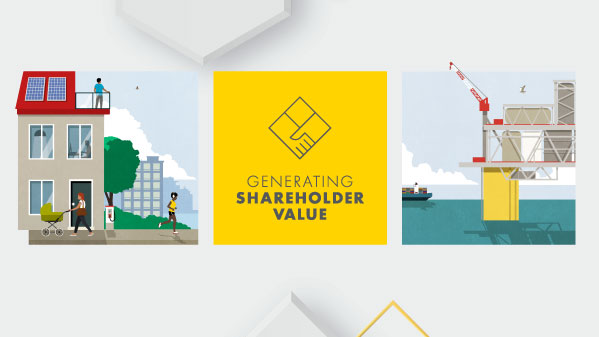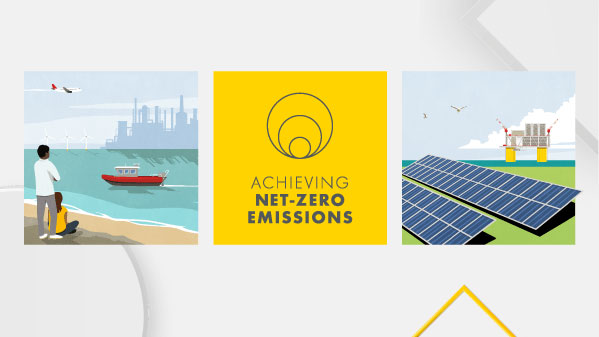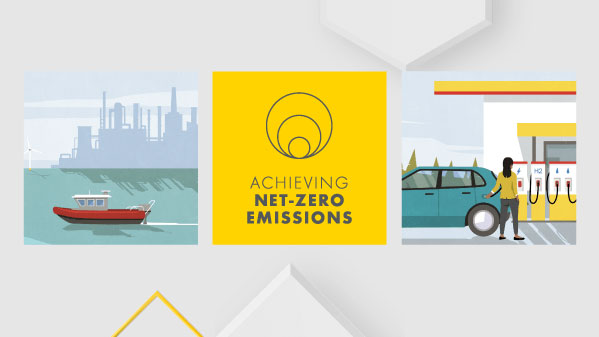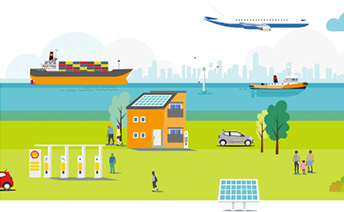Governance of climate-related risks and opportunities
Board oversight of climate-related risks and opportunities
Our governance framework is designed to effectively deliver on the energy transition ambitions of Shell’s Powering Progress strategy. See our Powering Progress strategy for detailed information.
The Board reviews our energy transition strategy periodically and oversees its implementation and delivery. In 2022, the Board considered climate-related matters throughout the year, including the assessment of climate-related risks and the effectiveness of corresponding risk management activities, and challenged and endorsed business plans, including consideration of major capital expenditures, acquisitions and divestments. In 2022, the Board convened eight times and continued to oversee the Powering Progress strategy and net-zero initiatives, including at the Board Strategy Day in June 2022. See “Governance” for further information.
Three Board committees provide primary oversight of the delivery of our energy transition strategy: the Safety, Environmental and Sustainability Committee (SESCo), the Audit Committee (AC) and the Remuneration Committee (REMCO). The importance of our energy transition strategy means that these committees are informed about climate-related matters on a frequent basis throughout the year. See “Climate change governance organogram” below.
The SESCo provides oversight of our technical delivery when it comes to reducing our carbon emissions, and the potential impacts and adaptation measures related to the physical risks of climate change. This includes reviewing our carbon management framework (CMF) and monitoring progress in reducing emissions to meet targets. The SESCo met five times in 2022 and discussed some aspects of climate-related matters at every meeting. After each meeting the SESCo Chair provided updates to the Board. See the SESCo’s activities in 2022 for further information.
Our AC provides oversight of the effectiveness of the risk management framework and the integrity of our financial reporting to ensure that our financial statements reflect the risks and opportunities associated with our energy transition strategy and climate change. During 2022, the AC convened six times and discussed climate-related matters on each occasion. More information on our Audit Committee’s activities in 2022 can be found in the Audit Committee Report.
The REMCO develops our remuneration policy and sets performance conditions designed to challenge and support the Executive Committee to reduce net carbon emissions while maintaining shareholder value. The REMCO met five times during 2022, with climate-related matters discussed at each meeting. Find more information on our Remuneration Committee’s activities in 2022 in the “Directors’ Remuneration Report” and the “Annual Report on Remuneration”.
Climate performance and remuneration
Energy transition targets were part of the 2022 annual bonus scorecard (15% weighting) for almost all of Shell’s employees, as well as the 2022 Performance Share Plan (PSP) awards (10% weighting) and the 2022 Long-term Incentive Plan (LTIP) for senior executives (20% weighting), both vesting in 2025. See “Directors’ Remuneration Report” for further information.
Find additional information on the Board’s oversight in “Governance framework”.
Management’s role in assessing climate-related risks and opportunities
Climate change management organogram [A]
The Chief Executive Officer (CEO) has the delegated authority from the Board to manage Shell’s actions in relation to the Company’s strategy, which includes climate change. The CEO is assisted on climate-related matters by members of the Executive Committee to implement Shell’s energy transition strategy and ensure that such matters are appropriately monitored:
- The Director of Strategy, Sustainability and Corporate Relations supports the CEO in developing Shell’s energy transition strategy, including climate scenarios development, and augmenting our CMF. The CMF includes the setting of carbon budgets for our businesses, and the implementation of carbon management activities.
- The Downstream Director is responsible for identifying and delivering climate-related opportunities, as well as managing and mitigating the climate risks of our existing Downstream businesses. The Sectors and Decarbonisation organisation supports the Downstream Director in implementing the sectoral decarbonisation approach.
- The Integrated Gas, Renewables and Energy Solutions Director is responsible for developing and advancing low-carbon solutions and opportunities, including those across our solar, hydrogen and wind businesses, as well as managing and reducing carbon emissions from our business.
- The Upstream Director is responsible for identifying and delivering low-carbon and emission-reduction opportunities in our oil and gas business. This includes managing and reducing our carbon emissions, for example, by reducing routine flaring and, in some cases, by using renewable energy to power our oil and gas extraction activities.
- The Projects & Technology (P&T) Director is responsible for setting emissions, climate, and reporting standards that are applicable to all our businesses. The P&T Director is also responsible for developing new technologies that will help our businesses to deliver on net-zero emissions reduction targets through both energy efficiency measures and solutions geared towards decarbonisation.
- The Chief Financial Officer (CFO) is responsible for monitoring the effective application of the Shell Control Framework, which provides the basis for managing our material risks including climate-related risks and opportunities, and the assurance over our financial information, carbon emissions and climate-related disclosures.
On January 30, 2023, Shell announced it would reduce the size of its Executive Committee from nine to seven members. The changes are expected to take effect from July 1, 2023. The Integrated Gas and Upstream businesses will be combined into a single Integrated Gas and Upstream Directorate. The Downstream business will be combined with Renewables and Energy Solutions to form a new Downstream and Renewables Directorate. The Strategy, Sustainability and Corporate Relations directorate will be discontinued, and Strategy, Sustainability and New Business Development will now report directly to the CFO. The new structure is aimed at enabling more streamlined planning and capital allocation decisions. The intention of this change is to simplify the organisation further and improve performance as we deliver our Powering Progress strategy.
Additional supporting governance
There are two key supporting management committees, with representatives from across Shell, which play a critical role in driving our energy transition strategy:
- The Capital Investment Committee (CIC) facilitates portfolio management discussions and reviews each investment opportunity that is, due to its size, subject to approval by the CEO or the Board. These reviews ensure that the climate risks and opportunities, together with other defined criteria including shareholder value, are embedded in investment decision-making. This committee is made up of senior executives, including the CEO, CFO, and individual business directors.
- The Carbon Reporting Committee (CRC) includes senior management representatives from business units, P&T climate-related disciplines and various functions, such as Strategy, Finance and Legal. This committee is tasked with ensuring that GHG emissions measures, both absolute emissions and carbon intensity, and associated metrics, comply with all regulatory and legal requirements. The CRC is responsible at Group level for the calculation methodologies and reporting of GHG emissions metrics, and the review and approval of external disclosures.
In addition to these committees, our network of country chairs supports the overall governance and development and deployment of climate-related initiatives. They facilitate the setting of each country’s plans in support of Powering Progress.
Processes by which management is informed about climate-related issues
Several processes are employed across the organisation to ensure that management teams can effectively monitor and manage climate-related matters. The management teams are helped by a combination of carbon-management-related standards and frameworks, forums at various levels of the organisation, and capability development programmes. These include our carbon management framework, carbon pricing, and the Greenhouse Gas (GHG) and Energy Management process, which forms part of our Health, Safety, Security, Environment and Social Performance (HSSE & SP) Control Framework.
Carbon management framework
Shell’s carbon management framework (CMF) helps us set carbon budgets in the operating plans for our businesses. The CMF seeks to manage and reduce emissions in a manner that is similar to how we use our financial framework. Carbon budgets are an effective measure for maintaining absolute emissions below a capped level, however achieving our intensity target is dependent on our energy product mix which is not driven by carbon budgets alone.
The CMF allows for carbon budgets to be allocated to our businesses and trade-offs between emitting carbon and generating shareholder value to occur within those budgets. The CMF helps inform portfolio decisions and support our decarbonisation targets. This provides leadership with the information required to make decisions on GHG reduction opportunities and portfolio choices required to achieve our decarbonisation targets.
For the 2022 operating plan cycle, our net carbon intensity (NCI) targets were translated into Scope 1, 2 and 3 (see definition below) carbon budgets for each business. These budgets were used to optimise the operating plans for each business.
Some examples of how our decarbonisation targets are taken into account in fundamental decisions across the organisation are as follows:
- Our businesses further embedded carbon emissions objectives in their respective Capital, Portfolio and Carbon forums. The forums consist of the most senior business management representatives who are responsible for active portfolio management through evaluation, and delivery of growth and divestment decisions.
- Certain assets are required to identify GHG abatement opportunities and reflect them in their annual business plans.
Greenhouse gas and energy management
Each Shell entity and Shell-operated venture is responsible for the development of its GHG emissions and energy management plans.
Our Greenhouse Gas and Energy Management process sets out Shell’s requirements for GHG reduction opportunities and portfolio choices to meet our carbon budgets and achieve our decarbonisation targets. These requirements allocate accountabilities for GHG and energy management within businesses, assets and projects, including responsibility for analysing our emissions, benchmarking performance, identifying improvement opportunities, and forecasting future performance. These requirements are applied to capital project delivery and through the asset-level annual business planning process, ensuring it is reflected in both opportunity realisation and strategic asset management planning.
A key aspect of the GHG and Energy Management process is the development of an energy efficiency and greenhouse gas reduction opportunity curve, economically assessed against the current and future costs of carbon. This information provides the basis for forecasts of absolute GHG emissions and associated intensities at the asset and project level. These forecasts are then aggregated to inform decisions on potential decarbonisation opportunities across our businesses.
A Global Process Council for GHG and Energy Management, led by the Global Process Owner for GHG and including business and functional experts, meets regularly to evaluate opportunities for the ongoing improvement of processes, tools, communications, and capabilities needed within the businesses to achieve our decarbonisation aspirations.
The requirements of our GHG & Energy Management Process are integrated into our annual business planning cycle.

Definition – Scope 1, 2 and 3 emissions
We follow the GHG Protocol’s Corporate Accounting and Reporting Standard, which defines three scopes of GHG emissions:
- Scope 1: direct GHG emissions from sources under Shell's operational control.
- Scope 2: indirect GHG emissions from generation of purchased energy consumed by Shell assets under operational control.
- Scope 3: other indirect GHG emissions, including emissions associated with the use of energy products sold by Shell.
Carbon pricing
We consider the potential costs associated with operational GHG emissions when we assess the resilience of new projects. For each region, we have developed short-, medium- and long-term estimates of future costs of carbon. These are reviewed and updated annually. See Note 4 to the “Consolidated Financial Statements” for further details on our regional cost of carbon estimates.
Up to 2030, costs for carbon emissions estimates are largely policy driven through emission trading schemes or taxation levied by governments and which varies significantly on a country-by-country basis. Beyond 2030, where policy predictions are more challenging, the costs for carbon emissions are estimated based on the expected costs of abatement technologies required for 2050. The costs are estimated to be at $125 per tonne (RT 2022) under Shell’s mid-price scenario. Under a high-price scenario, the costs are set at $220 per tonne (RT 2022), the top of the bioenergy with CCS cost range and the lower end of the direct air capture cost range.
See “The resilience of Shell’s strategy” for more information on how carbon costs impact Shell’s resilience to climate-related risks, including sensitivity analysis.











